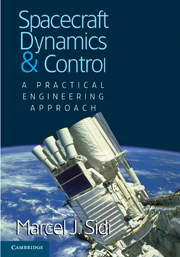Book contents
- Frontmatter
- Dedication
- Contents
- Preface
- Acknowledgments
- Chapter 1 Introduction
- Chapter 2 Orbit Dynamics
- Chapter 3 Orbital Maneuvers
- Chapter 4 Attitude Dynamics and Kinematics
- Chapter 5 Gravity Gradient Stabilization
- Chapter 6 Single- and Dual-Spin Stabilization
- Chapter 7 Attitude Maneuvers in Space
- Chapter 8 Momentum-Biased Attitude Stabilization
- Chapter 9 Reaction Thruster Attitude Control
- Chapter 10 Structural Dynamics and Liquid Sloshing
- Appendix A Attitude Transformations in Space
- Appendix B Attitude Determination Hardware
- Appendix C Orbit and Attitude Control Hardware
- Index
- References
Chapter 9 - Reaction Thruster Attitude Control
Published online by Cambridge University Press: 18 December 2014
- Frontmatter
- Dedication
- Contents
- Preface
- Acknowledgments
- Chapter 1 Introduction
- Chapter 2 Orbit Dynamics
- Chapter 3 Orbital Maneuvers
- Chapter 4 Attitude Dynamics and Kinematics
- Chapter 5 Gravity Gradient Stabilization
- Chapter 6 Single- and Dual-Spin Stabilization
- Chapter 7 Attitude Maneuvers in Space
- Chapter 8 Momentum-Biased Attitude Stabilization
- Chapter 9 Reaction Thruster Attitude Control
- Chapter 10 Structural Dynamics and Liquid Sloshing
- Appendix A Attitude Transformations in Space
- Appendix B Attitude Determination Hardware
- Appendix C Orbit and Attitude Control Hardware
- Index
- References
Summary
Introduction
In Chapters 5–8, various control laws were presented for attitude stabilization and maneuvering. The hardware used to implement the control laws were principally momentum exchange devices as well as magnetic and solar torque controllers. Such controllers work in a linear continuous mode. The torques that they can provide are in the range of 0.02–1 N-m for momentum exchange devices, 10−2–10−3 N-m for magnetic torque controllers, and 10−5–10−6 N-m for solar torque controllers.
This form of attitude control has two major disadvantages. First, the speed of attitude maneuvering is limited by the low-level maximal torques that can be delivered to the ACS. The second but no less important difficulty was encountered in orbit-maneuvering tasks. The high-level liquid thrusters (or solid propulsion motors) used for orbit changes induce parasitic torques due to physical irregularities of the propulsion system. The level of induced parasitic torques is of the order of several newton-meters. The only way to control the attitude of the spacecraft under such disturbance conditions is to use reaction thruster controllers (see also Section 8.8).
Reaction thrusters used in attitude control are activated in a pulsing mode only. There are no linear, continuous reaction thrust controllers. This fact somehow complicates the analytical treatment of attitude control systems using them as torque controllers. However, they can provide almost any torque level, as surveyed in Appendix C. Reaction torque levels ranging between 0.01 N-m and 30 N-m are very common in most spacecraft. For practical considerations, it is convenient to use thrusters of the same thrust level for all control tasks in the satellite, but if this is not feasible then thrusters with different thrust levels can be incorporated as part of a unified propulsion system.
This chapter deals with the analysis and design of reaction thruster attitude control. It also covers two principal difficulties caused by the pulsing mode of thruster firing: the limits on attitude accuracy that can be achieved with a given thruster, and the fuel penalty associated with sensor noise.
- Type
- Chapter
- Information
- Spacecraft Dynamics and ControlA Practical Engineering Approach, pp. 260 - 290Publisher: Cambridge University PressPrint publication year: 1997
References
- 1
- Cited by

